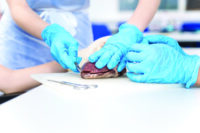Mealworms and superworms are probably best known for their use as feeder insects for chickens and reptiles, but they are both making news for very different reasons.
Not Worms at All
The first thing to know about these two critters is that they are not really worms. They are both larval stages of different darkling beetle species. The mealworm (Tenebrio molitor) is considerably smaller than the superworm (Zophobas morio). The superworm also has a darker head or tail. Its larger size makes it ideal food for large reptiles and chickens. Smaller reptiles, like leopard geckos should feed on crickets since superworms can bite and injure them. Larger reptiles, like bearded dragons, appreciate the extra fat content of the superworm as a special treat.



Superworms in the News
Superworms have recently made the news not for their role as food, but for what they can eat. According to a journal article published June 2022 in Microbial Genomics, researchers at the University of Queensland in Australia found that Zophobas morio can survive and complete metamorphosis on a diet of pure polystyrene (also known as Styrofoam). Scientists believe that they can do this because of the bacteria that live in their guts and make up their microbiome. In the wild, superworms and mealworms are important decomposers.
Mealworms in the News
Superworms are newsworthy because of what they can eat, and mealworms are newsworthy for who can eat them. As of 2021, the EU has approved mealworms for human consumption. While students (and others) in the US may turn their nose up at the idea of eating insects, many in the world are looking for sources of sustainable protein in a world with an expanding population. Given their high protein content (20.27%) and their ability to be fed vegetable matter that might otherwise go to waste, mealworms are a ready solution to the problems of hunger and malnutrition.
The US has not yet approved the insects for human consumption, however, so for now, stick to feeding them to your animals.
Caring for Superworms and Mealworms
Superworms and mealworms are both easy to care for in the classroom. Check out our care guides for mealworms and superworms. They can feed on bran meal and wheat germ supplemented by vegetable matter, such as apple or potato slices or banana peels. Fruits and vegetables should be removed before they become moldy, but make sure to keep some available as they provide a moisture source. Without the fresh produce as a source of moisture, the insects may resort to cannibalism.
Super Classroom Studies
In addition to their use as live food, superworms are interesting subjects for behavioral studies. They respond to a variety of stimuli, and their relatively large size and ease of maintenance make them interesting organisms for a variety of experiments including observing responses to temperature, moisture, and light. Mealworms can also be an ideal subject for insect life cycles. Depart from the traditional butterfly life cycle studies and try one of these for your next insect study.

Mealworms (Tenebrio)
Larvae are ideal food for lizards, salamanders, turtles, and frogs. Pupae metamorphose into adults in about 2 to 4 weeks. The adult lays hundreds of eggs and is the best stage to start a balanced culture.

Superworm (Zophobas morio)
A nutritionally superior live food source for large reptiles and amphibians. If maintained properly (not too much moisture), their shelf life may be 6 months or more! They are easy to maintain at room temperature (no refrigeration) and can be raised in peat or sawdust in a low, flat container.




